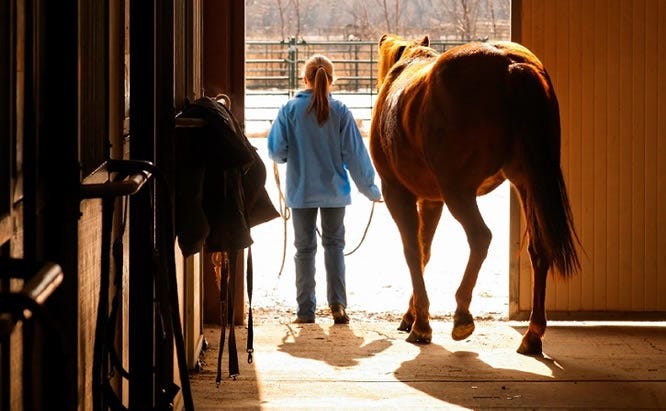Like any animal companion, horses bring immense joy, but understanding their care needs is paramount, especially as they demand significantly more attention than typical pets like dogs or cats. If you’re considering horse ownership, grasping the financial and time commitments involved is crucial for responsible care.
For a deeper understanding of the initial considerations, resources like “What to Consider About Horse Ownership” offer valuable insights into horse costs, necessities, and essential tips for raising horses. Adequate space is a primary need; horses require at least 1.5 acres of land per horse for sufficient turnout, and this area must be secured with proper fencing to ensure their safety and containment. Depending on your location, protective fencing may also be necessary to deter predators such as coyotes, wolves, and mountain lions. For further guidance on fencing, our electric fencing for horses guide is a helpful resource.
Establishing a Daily Horse Care Routine
Acquiring a horse is just the beginning of responsible ownership. A consistent daily care routine is vital for their health and overall well-being. A typical daily stable management and horse care routine includes several key tasks:
- Feeding: Provide horses with hay and/or grain both in the morning and evening. Proper nutrition is fundamental to their energy levels and health.
- Watering: Clean and refill water buckets twice daily to ensure access to fresh, clean water at all times. Hydration is critical for horses.
- Stall Cleaning (Mucking Out): Remove manure and urine-soaked spots from stalls twice a day. This process, known as mucking, is essential for hygiene.
- Bedding Management: Replace soiled bedding with fresh bedding daily to maintain a clean and comfortable environment for your horse.
- Hoof Care: Check and pick out hooves daily to remove stones, debris, and prevent potential issues like thrush. Regular hoof care is crucial for soundness.
- Blanketing (Seasonal): During colder months, remove blankets in the morning if temperatures rise and replace them in the evening to ensure your horse stays warm and comfortable.
- Fly and Insect Control (Seasonal): In warmer months, apply fly spray or insect repellent in the morning and evening to protect your horse from biting insects and the diseases they can carry.
- Turnout: Allow daily turnout in a pasture or paddock. This exercise allows horses to move freely, stretch their legs, roll, and graze, contributing to both physical and mental well-being.
- Exercise: Engage your horse in more structured exercise several times a week. This can include riding in an arena or on trails, or lunging, which involves exercising them in a circle on a long rein.
 Person caring for a horse by brushing its coat in a stable
Person caring for a horse by brushing its coat in a stable
The Dedication Behind Horse Care
Horses are naturally grazing animals, designed to consume small amounts of forage continuously throughout the day. This natural grazing behavior means they don’t inherently regulate their food intake and can overeat if given unlimited access to feed. Therefore, providing measured feed portions at least twice daily is crucial to prevent overeating and maintain a healthy weight. Consistent access to fresh, clean water is equally vital for their digestive health and overall bodily functions.
Maintaining a clean stall is paramount if your horse is stabled. Accumulated manure and waste create unsanitary conditions, attracting flies and potentially leading to hoof problems and other health issues. Daily stall cleaning is not just about aesthetics; it’s a fundamental aspect of responsible horse care, directly impacting their health and happiness.
While the list of daily tasks might seem extensive, horse care is genuinely a labor of love for those passionate about horses and ponies. Learning how to care for a horse encompasses far more than just grooming; it’s about attending to all their fundamental needs with dedication and knowledge.
Maintaining Stable and Tack
Horse care extends beyond the horse itself to include the upkeep of their equipment and living environment. Tack, which includes essential equipment like saddles, bridles, halters, lead ropes, and blankets, requires regular care. Leather tack should be cleaned and conditioned frequently to maintain its softness, pliability, and comfort for the horse. Blankets and saddle pads should be laundered regularly to prevent the buildup of mud and sweat, which can cause skin irritation and discomfort for your horse.
Stable chores are also an integral part of horse management. Regularly sweeping aisles to remove dust and manure, and removing cobwebs from ceilings and light fixtures are important for safety and hygiene. Cobwebs, especially those accumulating dust from hay and shavings, can become significant fire hazards in a stable environment.
Hands-On Learning for Horse Care
The most effective way to learn how to properly care for a horse is through practical experience under the guidance of an experienced horse person. This learning process could involve spending time at stables where you take riding lessons, asking questions, and observing daily routines. Alternatively, leasing a horse can provide a more immersive learning experience, allowing the horse’s owner to directly teach you about grooming, feeding, and all aspects of daily care.
Once you have a solid grasp of these fundamental horse care basics, you’ll be well-prepared for the responsibilities and rewards of horse ownership. Providing the best care possible ensures a healthy, happy, and fulfilling partnership with your horse.
